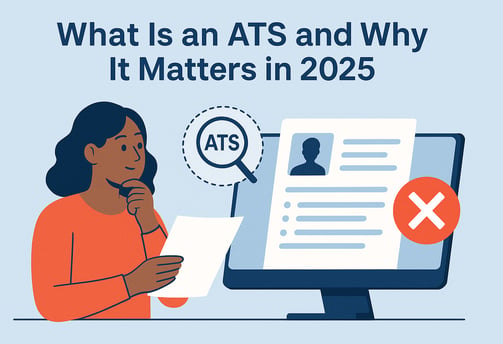What Is an ATS and Why It Matters in 2025
Learn how ATS works, why it matters in 2025, and how to build a resume that passes ATS filters. Tips, insights, and personal experience for job seekers in the digital hiring age.
Mihai Luca
6/19/20253 min read


After many years, I found myself back in the job market. Friends who had recently gone through the grind warned me about the long process—searching, applying, and taking tests for months. They all said the first genuine hurdle is the CV. It never even reaches a recruiter if it doesn't pass the ATS filter and highlight the right skills.
What Is an ATS and Why It Matter in 2025
If you've ever applied for a job online and never heard back, there's a good chance your resume never reached human eyes. Instead, it may have been filtered out by an Applicant Tracking System (ATS) — the digital gatekeeper of modern hiring.
What Is an ATS?
Companies use an ATS (Applicant Tracking System) to streamline hiring. It helps recruiters manage job postings, track applicants, and—most notably—scan and filter resumes before a human sees them.
Think of it as a search engine for resumes. It parses resumes for keywords, experience, education, and formats, ranks candidates, and sends the top scorers to HR. If your resume doesn't match the criteria or isn't formatted correctly, it may be rejected automatically.
Why Companies Use ATS
Efficiency: Large companies receive thousands of applications per role. ATS helps them narrow the field fast.
Organisation: Recruiters can manage candidate pipelines, communication, and feedback from a single dashboard.
Compliance: It ensures companies can track hiring decisions and comply with labour laws.
How ATS Works (in a Nutshell)
The job posting is created and published online.
Applications are often submitted through the company's career portal.
ATS parses resumes, pulling out names, skills, dates, job titles, etc.
Keyword matching compares resumes to the job description.
Ranking or scoring prioritises which candidates should be reviewed by humans.
Some advanced systems even use AI or machine learning to refine candidate suggestions based on past hiring decisions.
How to Beat the ATS
If you're applying for jobs in 2025, your resume must be ATS-friendly and human-readable. Here are some tips:
Use standard formatting. Avoid tables, columns, and fancy fonts.
Include relevant keywords. Mirror the job description without keyword stuffing.
Use standard section headings like "Experience," "Education," and "Skills."
Save as .docx or PDF — check what the employer requests.
Some tools (like Jobscan) help you optimise your resume for ATS compatibility.
Will follow up on using AI to help create and fix a CV.
Some ATS Myths
1. Myth: The ATS Automatically Rejects Candidates
Reality: ATS software filters, ranks, and makes applications searchable. Humans still review applications. Design your resume for people, not just machines.
2. Myth: Fancy Formatting Confuses the ATS
Reality: Modern ATS can read bullets, tables, and more. Use PDFs or Word documents. Avoid JPEG or RTF formats, which may cause issues.
3. Myth: ATS Only Looks for Exact Keyword Matches
Reality: Most ATS use semantic search to understand phrases and synonyms. Focus on showing how you meet the job's requirements.
4. Myth: You Should Copy and Paste the Job Description in White Font
Reality: Don't do this. The ATS will detect and possibly flag this tactic.
ATS Facts
1. Some ATSs have 'Knock Out' Questions
Example: "Are you a U.S. citizen?" These must be answered correctly to proceed.
2. Recruiters Can View All Your Applications in the ATS
Systems like Greenhouse, Workday, Lever, and Taleo let recruiters see your entire application history.
3. Applying Early Makes a Difference
Early applicants are more likely to be seen and reviewed first.
4. ATS Systems Are Customised by Companies
Most companies tweak off-the-shelf ATS software to fit their own needs. Don't waste time trying to play the specific systems.
ATS can be helpful, mainly when hundreds of people apply for a single role. I remember job postings with over a hundred people. In that sense, it's a necessary tool. While AI may improve how well it screens for skills, it still can't show who the person truly is. It makes the process feel detached as if we're all just checkboxes instead of individuals.
Innovate
Explore technology, gaming, and programming insights here.
Connect
Showcase
info@bytechirp.com
© 2024. All rights reserved.
